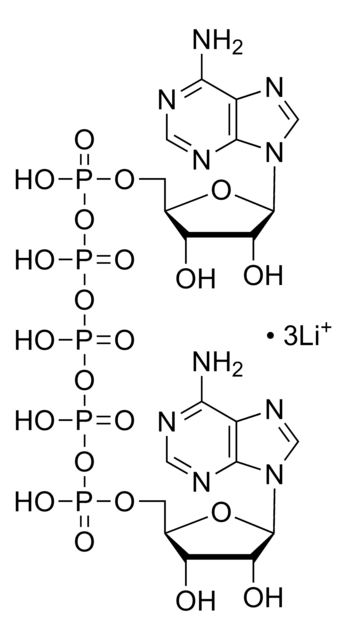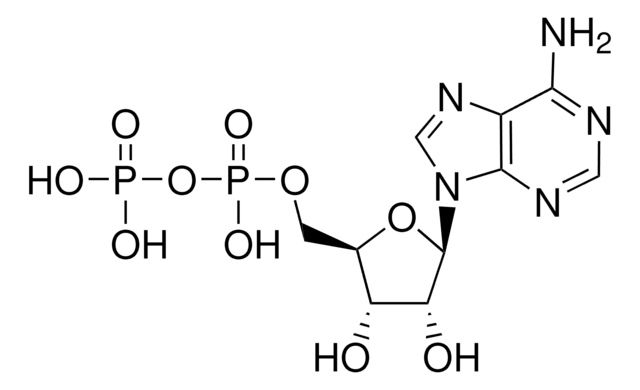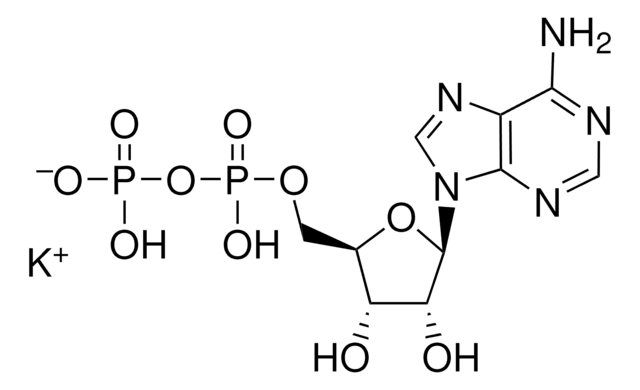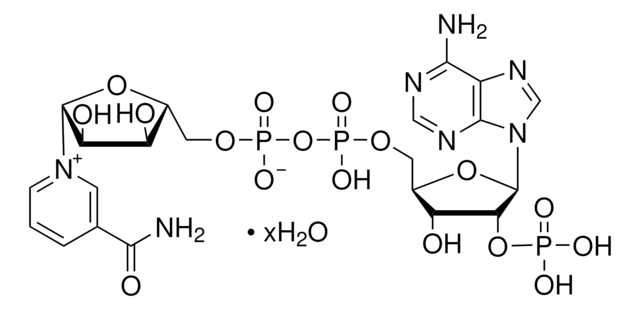Key Documents
D4022
P1,P5-Di(adenosine-5′) pentaphosphate pentasodium salt
≥95% (HPLC), powder
Synonim(y):
A(5′)P5(5′)A, Diadenosine pentaphosphate pentasodium salt
About This Item
Polecane produkty
pochodzenie biologiczne
synthetic (organic)
Próba
≥95% (HPLC)
Postać
powder
masa cząsteczkowa
~_1.0 kDa
kolor
white to yellow-white
rozpuszczalność
H2O: 50 mg/mL
temp. przechowywania
−20°C
ciąg SMILES
[Na+].[Na+].[Na+].[Na+].[Na+].Nc1ncnc2n(cnc12)[C@@H]3O[C@H](COP([O-])(=O)OP([O-])(=O)OP([O-])(=O)OP([O-])(=O)OP([O-])(=O)OC[C@H]4O[C@H]([C@H](O)[C@@H]4O)n5cnc6c(N)ncnc56)[C@@H](O)[C@H]3O
InChI
1S/C20H29N10O22P5.5Na/c21-15-9-17(25-3-23-15)29(5-27-9)19-13(33)11(31)7(47-19)1-45-53(35,36)49-55(39,40)51-57(43,44)52-56(41,42)50-54(37,38)46-2-8-12(32)14(34)20(48-8)30-6-28-10-16(22)24-4-26-18(10)30;;;;;/h3-8,11-14,19-20,31-34H,1-2H2,(H,35,36)(H,37,38)(H,39,40)(H,41,42)(H,43,44)(H2,21,23,25)(H2,22,24,26);;;;;/q;5*+1/p-5/t7-,8-,11-,12-,13-,14-,19-,20-;;;;;/m1...../s1
Klucz InChI
NNMFUJJMJIYTSP-CSMIRWGRSA-I
Szukasz podobnych produktów? Odwiedź Przewodnik dotyczący porównywania produktów
Opis ogólny
Zastosowanie
- an adenylate kinase (AK) inhibitor in: sarcoma osteogenic (Saos-2) cells
- mitochondrial lysates during ATP synthesis
- tetramethylrhodamine methyl ester (TMRM) based membrane potential assay
- chromoplasts
Działania biochem./fizjol.
Kod klasy składowania
11 - Combustible Solids
Klasa zagrożenia wodnego (WGK)
WGK 3
Temperatura zapłonu (°F)
Not applicable
Temperatura zapłonu (°C)
Not applicable
Środki ochrony indywidualnej
Eyeshields, Gloves, type N95 (US)
Certyfikaty analizy (CoA)
Poszukaj Certyfikaty analizy (CoA), wpisując numer partii/serii produktów. Numery serii i partii można znaleźć na etykiecie produktu po słowach „seria” lub „partia”.
Masz już ten produkt?
Dokumenty związane z niedawno zakupionymi produktami zostały zamieszczone w Bibliotece dokumentów.
Klienci oglądali również te produkty
Nasz zespół naukowców ma doświadczenie we wszystkich obszarach badań, w tym w naukach przyrodniczych, materiałoznawstwie, syntezie chemicznej, chromatografii, analityce i wielu innych dziedzinach.
Skontaktuj się z zespołem ds. pomocy technicznej












